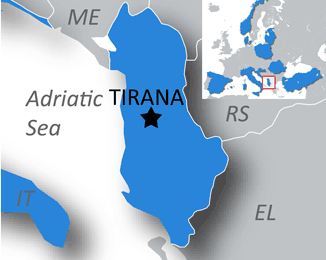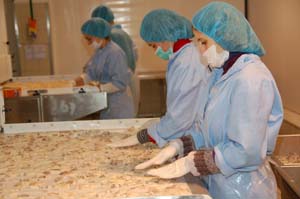 Tirana
Tirana Population: 2.79 million
(2022, Eurostat)
Population: 2.79 million
(2022, Eurostat) GDP: €17.9 billion (2022, Eurostat)
GDP: €17.9 billion (2022, Eurostat) GDP/capita: €5 390 (2021, Eurostat)
GDP/capita: €5 390 (2021, Eurostat)

Overview of the Albanian fisheries and aquaculture sector
Marine fisheries sector

Albania is a country rich in water resources, with a 380 km coastline, of which 284 km stretches along the Adriatic Sea in the north and the remaining 96 km faces the Ionian Sea. Albania has six small, uninhabited islands in the Mediterranean. There are eight large coastal lagoons that support commercial fisheries, ranging from Butrint on the Greek border in the south to Velipoja on the border with Montenegro to the north. The total lagoon area is about 10 600 hectares. They represent the most important part of the country’s coastal ecosystems. The fisheries sector in Albania is relatively small, but it is important from a socio-economic point of view as it is a significant source of jobs in coastal and remote areas.
The marine and coastal fisheries are the most important sub-sectors of the national capture fisheries. Marine resources in Albanian waters are shared Adriatic stocks. Marine fisheries are divided into commercial industrial fisheries and commercial artisanal fisheries. The difference between industrial and artisanal fisheries is based on the type of fishing gear used by license holders. All forms of trawling and purse seining, regardless of the technical characteristics of the nets that are used, are regarded as industrial fishing activities.
The artisanal fishery covers all forms of fishing activity using fixed and selective gear such as hooks, fixed nets, trammel nets, and gill nets.
As a member of GFCM, Albania is subject of catch limitations: from 2019, fishing vessels should not exceed 180 fishing days per year, with a maximum of 144 fishing days targeting sardine and 144 fishing days targeting anchovy.
In 2022, the fishing fleet comprised 784 licensed vessels and is concentrated in the six fishing ports of Durres, Himara, Lushnje-Fier, Saranda, Shengjin and Vlora. The largest is the port of Durres which accommodated 37.2% of all the vessels, followed by Vlora with a 30.5% share, and Saranda with 15.8%. The coastal fleet consisted of 556 gill netters,196 trawlers, 10 purse seiners, 5 dredges, and 17 multipurpose vessels. Landings from offshore marine fisheries in 2022 amounted to 4 319 tonnes, fishing in the lagoons added some 200 tonnes, while the coastal fisheries produced 984 tonnes.
Marine catches consisted mainly of deep-water rose shrimp (Parapenaeus longirostris) and European anchovy, each providing 18% of the total catch volumes, while other important species were European hake, European Pilchard, and Surmullets nei.
Inland fisheries
In Albania, there are 247 natural lakes with a total surface area of 1 210 sq. km, and eight large lagoons with a total area of 10 000 ha. Major fishing gear are gillnets, beach nets, and hooks. The inland capture fishery contributes a significant amount to the overall capture fishery, on average delivering over 25% of the volumes annually.
Fishing takes place mainly in five lakes, four of which are large cross-border lakes: Shkodra, Ohrid, and the major and minor Prespa lakes. The Shkodra Lake is the largest of the four and the fishery there is managed by the local fishery management organisation (FMO). There are 420 members (subjects) in the FMO, each of which comprises two people and one boat. Members are allotted a certain part of the lake in which they can fish, but they can apply to the FMO to change the area if they wish to move to another part. Among the most valuable species caught in the Shkodra Lake are carp, roach, and bleak together with smaller amounts of mullet and eel. Ohrid lake is famous for its native fish fauna including koran (Ohrid trout – Salmo letnica) and the belvica (Salmo orhidanus).
In 2022, the inland catch amounted to 3 388 tonnes, where cyprinids (mainly common, bighead, and silver carps) contributed more than 50%. Other major species included roaches, mullets, and European perch.
It shall be noted that the data on Albania’s inland fisheries in rivers is not collected, so the total contribution of the inland fisheries is higher than officially reported.
Aquaculture

During the past decade, Albania’s aquaculture production has expanded due to an upsurge in all types of aquaculture activities. During the period between 2015 and 2019, aquaculture sub-sector contributed about 30% of the total country’s total fisheries production, while in 2022 its share exceeded 50%. About ten species are cultured, of which the main ones are sea bass and sea bream, rainbow trout, mussels, and cyprinids.
Marine cage culture activities are concentrated in the Ionian Sea where gilthead sea bream (Sparus aurata) and European sea bass (Dicentrarchus labrax) are produced. Mediterranean mussel (Mytilus galloprovincialis) cultivation is concentrated in the Butrinti lagoon with some activity also in the open sea at Shengjini Bay (around 100 ha with floating lines). The highest production volumes of mussels were observed in 1980 and reached 5 000 tonnes. After the introduction of the EU ban on mussel exports from Albania in 1990, the production volumes dropped to the level of about 1 200 – 1 500 tonnes per year as maximum. Another limiting factor is annual damages from high temperatures during summer, when grown mussels and the seeds die causing the decline in production in the following year. In this view the Burtini lagoon is the most vulnerable.
Trout farming in raceways is another important form of finfish aquaculture and is concentrated in the southeast of Albania, where numerous companies have their ponds. Cultivation of the endemic koran is restricted to the area near lake Ohrid. A few hatcheries are involved in the cultivation of common carp (Cyprinus carpio), Chinese carps such as grass carp (Ctenopharyngodon idellus), bighead carp (Hypophthalmichthys nobilis), and silver carp (Hypophthalmichthys molitrix) for restocking purposes. Special attention is paid to restocking of koran: in 2022, about 1.6 million juveniles were produced and released to the lake Ohrid, exceeding the number from the previous year by 14%. A significant contribution was made by producing and releasing 9 million juveniles of rainbow trout.
The development of the aquaculture sector in the last several years has followed domestic consumer demand, especially for marine finfish products – sea bass and sea bream in particular.
In 2022, the total marine and inland aquaculture production of finfish was 7 986 tonnes, while mussel production amounted to 922 tonnes. The latest available data indicate that in 2020 the total number of farms was 113, employing 620 people (full-time equivalent).
Sea bass and sea bream are the major cultivated species yielding over 70% annually, while trout contributes between 17 and 20% of the total aquaculture volumes.
Processing and trade

The fish processing industry is concentrated around the main ports of Shengjin, Durres, Vlore, and Sarande. In 2020 there were 28 fish processing plants in Albania, and all of them were certified to supply not only the domestic market, but also to export to the EU. Major species processed are anchovy, sardine, and other small pelagic species for export primarily to the EU.
The total imports of fisheries and aquaculture products reached 38 727 tonnes in 2022 with a total value exceeding €145 million. Over 60% of the volumes came from the EU countries. Italy with 16% share of the total volumes and Croatia with 14% were the major exporters to Albania supplying mainly anchovies. Outside the EU Greenland was the major supplier with 11% share of the total.
In 2022 the export volumes of fisheries products amounted to 18 855 tonnes worth almost over 133 million euros, of which preserved and prepared products were about 50% both in volume and value. EU countries absorbed over 90% of Albania’s seafood exports both in terms of volume and value. The main destinations for Albanian exports are Italy with over 60% of the export volumes, followed by Sweden (14%), Spain, and Norway – both 5%. Albania does not export aquaculture products, with the exception of some processed (marinated) molluscs. Exports concentrate on anchovies, including canned, for the Italian market, as important Italian trademark owners opened plants in Albania taking advantage of the lower labour costs.
Consumption
Albanian consumers have traditionally preferred meat and poultry products over seafood. Fish consumption is mainly limited to the coastal regions of the country. It is estimated that about 70% of the population in Albania prefers wild fish and seafood products over farmed fish. Farmed trout is sold mainly on the domestic market, while marine fish are mostly exported to the EU market and neighbouring Balkan countries.
In recent years, the national average household consumption of fish and seafood has fluctuated; FAO puts the estimate at 8.68 kg in 2020. (https://ourworldindata.org/grapher/fish-and-seafood-consumption-per-capita?tab=chart&time=earliest..latest&country=~ALB)
Economic value of fisheries and aquaculture
Estimates put the contribution of fisheries and aquaculture to Albania’s GDP at about 0.3%. While the fisheries sector is relatively small, it is important from a socio-economic point of view because it is often located in areas of high unemployment and socio-economic needs. Estimates put the contribution of fisheries and aquaculture to the GDP at about 0.3%.
Useful Links for Albania
If any of the above listed links do not work or if you have a relevant link to add, send us an email here.









